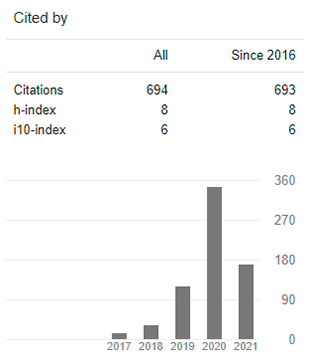Cultivation of Cocoa (Theobroma cacao linnaeus) as an Item for the Sustainability of Soils
(Project in Development)
DOI:
https://doi.org/10.29394/Scientific.issn.2542-2987.2019.4.13.4.78-89Keywords:
cultivation, subsistence agriculture, agricultural landAbstract
The present investigation that as a general objective proposes the Cultivation of cocoa (Theobroma cacao linnaeus) as an item for the sustainability of the soils to the Farmers of the El Tesoro Farm, Parish of Ciudad Bolivia, Pedraza municipality, Barinas State, fixes its investigative approach in the quantitative paradigm , as a special project, based on the design of an Exploratory Character Field to be executed in four stages: 1. Diagnosis, 2. Design, 3. Application, and 4. Systematization. Direct observation will be applied in field practices, in addition to questionnaire-type surveys with a Likert-type frequency scale of five (5) alternative responses to the producers of the aforementioned farmhouse; the validity will be executed with the judgment of experts, the reliability will be measured by the Cronbach's Alpha to determine the degree of legitimacy and effectiveness of the instruments. The analysis of the collected data will be done by means of tables and graphs with their respective description for their better interpretation. Being a study in process, it is expected that the results to obtain positively transform the reality of the community as producers deteriorate the soil with their agricultural practices and it is necessary to make changes that allow having an environmental culture that generates both economic and ecological benefits in favor of sustainability.
Downloads
References
Brickell, C.D. et al. (eds) (2009). «International Code of Nomenclature for Cultivated Plants». Scripta Horticulturae. 8th edition. International Society of Horticultural Science, 10: 1-184, ISBN: 978-0-643-09440-6. Spencer y Cross, 2007, p. 938. United States: CSIRO Publishing.
Calva, J. (Coord.), Alba, C., Asuad, N., Bustamante, C., Cardena, F., Carrillo, H... Torres, F. (2007). Sustentabilidad y Desarrollo Ambiental. Agenda para el Desarrollo. Volumen 14, ISBN: 970-32-3532-8. México, D.F.: Dirección General de Publicaciones y Fomento Editorial de la Universidad Nacional Autónoma de México.
Dubois, A. (2007). Producción agrícola y conservación de la biodiversidad: ¿Dos actividades compatibles? El caso de los sistemas agroforestales con cacao en Talamanca - Costa Rica. Francia: Université Jean Moulin Lyon 3. Recuperado de: http://repositorio.bibliotecaorton.catie.ac.cr/handle/11554/3493?show=full
Harvey, C., González, J., & Somarriba, E. (2006). Dung beetle and terrestrial mammal diversity in forests, indigenous agroforestry systems and plantain monocultures in Talamanca, Costa Rica. Biodiversity and Conservation, 15(2), 555-585, e-ISSN: 1572-9710. Recuperado de: https://doi.org/10.1007/s10531-005-2088-2
Hernández, R., Fernández, C., & Batista, P. (2012). Metodología de la Investigación. 4ta Edición, ISBN: 968-422-931-3. México: McGraw-Hill Interamericana.
ICCO (2006). Informe Anual 2004/2005. Londres, Reino Unido: Organización Internacional del Cacao. Recuperado de: https://www.icco.org/about-us/international-cocoa-agreements/doc_download/26-spanish-2004-2005-annual-report.html
Cabezas, S., Mavisoy, K., Ballesteros, W., & Somarriba, E. (2009) Evaluación de la abundancia de Ceratopogonidos (Díptera) polinizadores de cacao (Theobroma cacao L) en la hojarasca de 7 árboles de sombra, Talamanca - Costa rica. Pasto, Colombia: Facultad de Ciencias Agrícolas de la Universidad de Nariño. [Documento en línea]. Recuperado de: http://biblioteca.udenar.edu.co:8085/atenea/biblioteca/80071.pdf
UPEL (2006a,b,c). Manual de Trabajos de Grado de Especialización y Maestría y Tesis Doctorales. 4ta Edición, ISBN: 980-273-441-1. Caracas, Venezuela: Fondo Editorial de la Universidad Pedagógica Experimental Libertador - FEDUPEL.
Downloads
Published
How to Cite
Issue
Section
License
Copyright (c) 2019 INDTEC, C.A.

This work is licensed under a Creative Commons Attribution-NonCommercial-ShareAlike 4.0 International License.
The content of the journals of this site, are under a Creative Commons Attribution-Noncommercial-Share Alike 4.0 International License.













